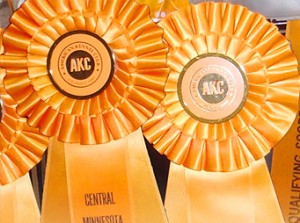Maybe The Most Expensive Orange Ribbons Evah!
356 – The Annual, 2018-19
By Chris Robinson
 When Bo, my young Chesapeake Bay Retriever, finished his junior hunter title last summer, the conservative cost figure for each of those ribbons, I thought, was probably about a thousand bucks apiece. However, when I took a look at my tax summaries for the past two years, it was clear that I underestimated the cost of each of those ribbons by about one-third! How in God’s name, you ask, could we have possibly rung up a bill of $6,000 for four orange ribbons at the junior level? It was surprisingly easy because it wasn’t exactly a smooth path to his title. In fact, there were times when the road to his JH had potholes; big enough to conceal a full-grown pachyderm!
When Bo, my young Chesapeake Bay Retriever, finished his junior hunter title last summer, the conservative cost figure for each of those ribbons, I thought, was probably about a thousand bucks apiece. However, when I took a look at my tax summaries for the past two years, it was clear that I underestimated the cost of each of those ribbons by about one-third! How in God’s name, you ask, could we have possibly rung up a bill of $6,000 for four orange ribbons at the junior level? It was surprisingly easy because it wasn’t exactly a smooth path to his title. In fact, there were times when the road to his JH had potholes; big enough to conceal a full-grown pachyderm!
The first major “cost increase” came about because I decided to train Bo using only, as much as possible, positive reinforcement techniques, simply because his temperament and personality dictated that any heavy-handedness in training would result in a complete and total shutdown by him. So, right from the git-go, it was obvious this decision was going to add significantly to the cost of any field title because neither Craig Klein, Bo’s professional trainer, nor I, who had put more than 50 field titles on my dogs over the years, had a clue how to go about employing pos- itive training for a hunting dog. Both of us were well-schooled in the old, tried-and-true, coercive training methods that had produced hundreds of field champions, and an equal, or greater num- ber, of master hunters, but it was clear those techniques were going to be a non-starter with Bo.
There’s not exactly a plethora of books or instruction DVDs available on how to train a hunting dog using positive training techniques, and those that are available, for the most part, rely fairly heavily on the use of clicker training. There was just one big problem with using a clicker with Bo. He did not consider a couple of “clacks” from a mechanical toy similar to the one issued to the 82nd and the 101st Airborne Divisions, just prior to the invasion of Normandy in WWII to aid these paratroopers in identifying “friend” or “foe” in the dark of night behind enemy lines before D-Day, to be an adequate reward for whatever we were asking him to do. In fact, instead of identifying it as being a “friendly,” there was considerable evidence that he viewed the “clack” or “clack-clack” as a “foe.” So, instead of a dog making progress in training to a series of clack-clacks, I kept hearing “cha-ching, cha-ching, cha-ching,” as my mental calculator began adding more expense to Bo’s training and thus, ultimately, the cost of his title as both Craig and I were forced to use a lot of trial and error to come up with ways to teach the dog the things he needed to learn without resorting to negative reinforcement.
Click here to read the complete article356 – The Annual, 2018-19
Short URL: https://caninechronicle.com/?p=156394
Comments are closed











